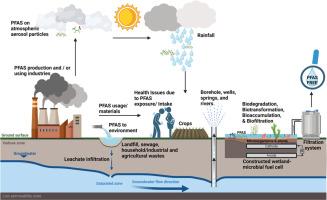Degradation pathways of perfluoroalkyl and polyfluoroalkyl compounds: Removal in water and soil using fungi and plant-based remediation
Q2 Environmental Science
引用次数: 0
Abstract
Many known purification systems have failed in the removal of per- and poly-fluoroalkyl substances (PFASs), and there is no known natural degradation process. PFAS are a group of synthetic fluoroorganic compounds that have a unique dual nature of both lipophobic and hydrophobic, as well as high-energy chemical bonds that make them pervasive in the environment. Currently, these compounds receive less attention; however, they pose serious health problems. Studies have shown PFAS's dispersion pathways, health concerns, and suggestions for their removal in soil and water, but there is still limited information on the natural or subjective degradation of the compounds. Several technologies, such as phytoremediation, reverse osmosis, nanofiltration, and photolysis, have been demonstrated to remove PFAS. However, these techniques come with their challenges and drawbacks, especially in the complete removal of the compounds. Thus, this overview described the pathways and mechanisms of some PFAS, including biotransformation pathways of 6:2 FTOH, biotransformation and degradation pathways of 8:2 FTOH, and fragmentation pathways for PFOA, PFOS, and 8:2 FTOH, degraded by the Phanerochaete chrysosporium fungus. Furthermore, this study suggests that the integration of plants and fungi into constructed wetland technology holds promise for effective PFAS removal.

全氟烷基和多氟烷基化合物的降解途径:利用真菌和植物修复技术去除水和土壤中的物质
许多已知的净化系统都无法去除全氟烷基和多氟烷基物质(PFAS),也没有已知的自然降解过程。PFAS 是一组合成的氟有机化合物,具有独特的疏油和疏水双重性质以及高能化学键,使其在环境中无处不在。目前,这些化合物受到的关注较少,但它们却带来了严重的健康问题。研究显示了 PFAS 的扩散途径、健康问题以及在土壤和水中清除它们的建议,但有关这些化合物的自然降解或主观降解的信息仍然有限。植物修复、反渗透、纳滤和光解等几种技术已被证明可以去除 PFAS。不过,这些技术也有其挑战和缺点,尤其是在完全去除化合物方面。因此,本综述描述了一些 PFAS 的途径和机制,包括 6:2 FTOH 的生物转化途径、8:2 FTOH 的生物转化和降解途径,以及 Phanerochaete chrysosporium 真菌降解 PFOA、PFOS 和 8:2 FTOH 的破碎途径。此外,这项研究还表明,将植物和真菌与建造湿地技术相结合,有望有效去除全氟辛烷磺酸。
本文章由计算机程序翻译,如有差异,请以英文原文为准。
求助全文
约1分钟内获得全文
求助全文
来源期刊

Environmental Advances
Environmental Science-Environmental Science (miscellaneous)
CiteScore
7.30
自引率
0.00%
发文量
165
审稿时长
12 weeks
期刊介绍:
 求助内容:
求助内容: 应助结果提醒方式:
应助结果提醒方式:


